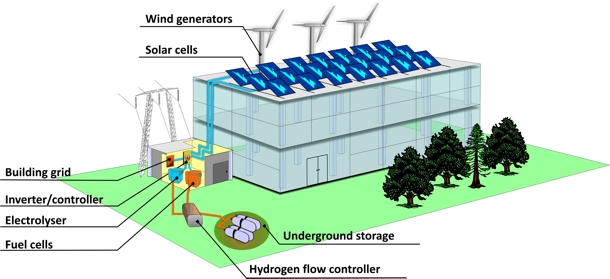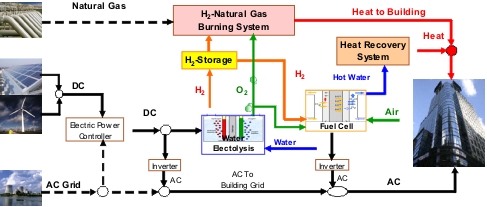
Our concept is the development of an intelligent, self-sustained and zero CO2
emission hybrid energy system to cover electric power,
heating and cooling loads (tri-generation) of either
residential/commercial buildings or districts of buildings.
In the proposed system, the primary energy will be
harvested from RES and directly used to cover contingent
loads, while the excess energy will be converted to hydrogen
to be used as energy storage material and to be further
applied as a green fuel to cover the building
heating needs through direct combustion or to produce
combined heating and electricity by means of fuel cells. The
concept of the proposed idea is schematically presented in
Fig. 1.

Fig. 1 Conceptual diagram of a RES - H2 building energy system
The energy needed to cover the building needs originates exclusively from RES (solar, wind and
hydro power where available) and is used either
directly as electricity to cover the building
electrical loads or stored as chemical energy in the
form of hydrogen. Hydrogen is produced in the
building from water by electrolysis. The stored hydrogen is
used as a green fuel to: a) cover the building heating needs
through its CO2-free combustion (2H2+O2=2H2O)
in suitably designed burners and b) level and balance the intermittent nature of RES, by storing the excess energy
produced by the RES (e.g. in commercial buildings during weekends, when energy consumption is minimum) or by
providing the electricity needed to cover the building electrical loads in periods (e.g. during night, cloudy or
windless days) when either RES are not effective enough to produce it. The latter is achieved with the direct
conversion of hydrogen energy into electrical energy in appropriately designed
fuel cells (CHP), integrated in the building electrical grid. The
heat produced by hydrogen burning in the fuel cells is recovered and used to cover part of the building heating
needs.
The energy generation and distribution in the building and
the safe operation, control and monitoring of the various
system modules is managed by an intelligent
energy and device management system developed
for the specific application. In order to secure a stable
and continuous operation, the proposed system is connected
to the main electrical and natural gas utility grid and uses
them only in cases of energy shortage (e.g. in-house energy
production is not enough, malfunctions, repair or service).
The main parts of the proposed system include photovoltaic
array(s), wind generator(s), electrolyser, fuel cells,
hydrogen storage tanks and intelligent management and
control system. The system will be applicable both
in residential and commercial buildings.
Successful achievement of this target will significantly contribute to the realisation of the targets set by the EC and will address one of the major challenges of the 21st century for the Building Sector.
H2SusBuild poster can be downloaded by clicking here.
H2SusBuild brochure can be downloaded by clicking here.

